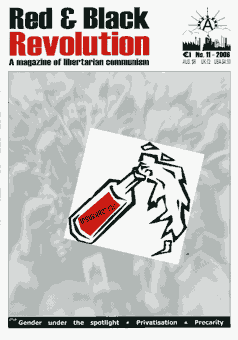Over 30 years of anarchist writing from Ireland listed under hundreds of topics
Focus on precarity - Change To Win (USA)
Last September saw a split in the USA’s Congress of Trade Unions, the AFL-CIO. The Change to Win Federation held its founding convention in St. Louis, Missouri, where they set out their plans: cut down on bureaucracy, devote a lot more resources to organising the unorganised, and start building industry-wide super-unions.The seven founding unions were the Teamsters (a general union and the USA’s biggest), the Building Labourers, Service Employees (third biggest in the USA), UNITE-HERE (clothing and restaurant workers), Farmworkers, Food workers, and the Carpenters. Together they made up about 35% of the AFL-CIO's members.
Literally from day one, we could see this was not going to be some radical break from the undemocratic practices of the AFL-CIO. There was no membership vote over affiliation to this new federation, the handful of people on each union executive took the decision themselves.
So, is this new formation simply an attempt by a few discontented senior union leaders to increase their power or do they have ideas that merit serious consideration? Most of their literature has been long on describing the problems faced by working people, but short on offering solutions.
Well, there are very real problems in the US trade union movement. Whether you are a radical or a conservative, you can’t avoid the fact that the percentage of American workers in a union has dropped to an all-time low of about 12%. And that’s an open invitation to the bosses to stick the boot in, an invitation the bosses have been more than happy to accept.
“We are focusing our resources on organising tens of millions of workers who are without union representation. We are shifting our resources into organising”, said Anna Burger, Change to Win Chair. Indeed the federation has put it like this:
“1. Working people, including current union members, cannot win consistently without uniting millions more workers in unions.
2. Every worker in America has the right to a union that has the focus, strategy, and resources to unite workers in that industry and win.”
Among their proposals to achieve these objectives are encouraging unions to organize on an industry- wide basis, merging smaller unions into a few large unions, and spending more money on organising as opposed to electoral politics.
All well and good, but unions have to be seen to do more than merely hold the line against employer demands for cutbacks. They need to actually spearhead a fight for higher wages, more job security, better healthcare, shorter hours and improved pensions. There has to be a sense that we are going forward, that any sacrifices or risks we are asked to take will be worth it.
Just as important, even a brief look at labour history suggests that ideas, politics, and grassroots worker involvement are far more important than changes in organisational structures in the recipe for reviving union strength.
There are no shortcuts to rebuilding our movement, and that it will take far more than a few mergers or spending more on recruitment to produce the reversal in union fortunes that so many of us desire. After all, that’s what has been done here by SIPTU and IMPACT, to name but two of our own big unions which were formed through mergers.
This is not to say that the heads of the new federation are “sell-outs”, “traitors” or any of the other silly names that sometimes get thrown at union leaders. By and large they represent the general ideas of the members who elected them. When most workers see no alternative to the conservative political parties, let alone to capitalism, we should not be surprised that our unions are not some sort of revolutionary movement.
What is needed is not “better leaders”. We are not sheep who simply require a better or more farsighted shepherd. Real change necessitates the active participation of a lot of people.
All over the world we need to convince our work colleagues and fellow union members that a militant fight for workers’ interests is a good thing, that ordinary member involvement and control of our unions is a good thing, that a fundamental change in the way society is ordered is possible.
In our unions, whether in the USA or Ireland, experience suggests that we need a programme that puts far greater weight on political and social change, rank-and-file education and empowerment, and a commitment to reinvigorating collective bargaining as well as rebuilding membership. This was the experience of Connolly and Larkin, of the US Congress of Industrial Organisations in the 1930s, and of every large-scale union movement since.
This article is from Red and Black Revolution 11, published October 2006

Read the rest of the articles in this issue online
Download the PDF file

